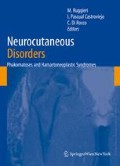Abstract
Multiple endocrine neoplasia type 2 (MEN 2) is a distinct hereditary syndrome that has an autosomal pattern of inheritance (OMIM 2005). There have been 500-1000 MEN 2 kindreds reported in the literature. The MEN 2 syndrome consists of three variants: MEN 2A, MEN 2B and familial medullary thyroid cancer (Table 1). Patients with MEN 2B develop medullary thyroid cancer (100%), pheochromocytoma, mucocutaneous neuromas and have characteristic physical features. MEN 2B accounts for 5–10% of MEN 2 cases. In patients with MEN 2B, neuromas may involve the skin, musculoskeletal system, gastrointestinal tract and eyes (Schimke et al. 1968, Williams and Pollock 1966a).
Access this chapter
Tax calculation will be finalised at checkout
Purchases are for personal use only
Preview
Unable to display preview. Download preview PDF.
References
Baloh RH, Enomoto H, Johnson EM Jr, Milbrandt J (2000) The GDNF family ligands and receptors-implications for neural development. Curr Opin Neurobiol 10: 103–110.
Boord JBBL (2004) Multiple endocrine neoplasia type 2. In: Roach ESMV (ed.) Neurocutaneous disorders. New York: Cambridge University Press, pp. 105–111.
Brandi ML, Gagel RF, Angeli A, Bilezikian JP, Beck-Peccoz P, Bordi C, Conte-Devolx B, Falchetti A, Gheri RG, Libroia A, Lips CJ, Lombardi G, Mannelli M, Pacini F, Ponder BA, Raue F, Skogseid B, Tamburrano G, Thakker RV, Thompson NW, Tomassetti P, Tonelli F, Wells SA Jr, Marx SJ (2001) Guidelines for diagnosis and therapy of MEN type 1 and type 2. J Clin Endocrinol Metab 86: 5658–5671.
Brauckhoff M, Gimm O, Weiss CL, Ukkat J, Sekulla C, Brauckhoff K, Thanh PN, Dralle H (2004) Multiple endocrine neoplasia 2B syndrome due to codon 918 mutation: clinical manifestation and course in early and late onset disease.World J Surg 28: 1305–1311.
Eng C, Clayton D, Schuffenecker I, Lenoir G, Cote G, Gagel RF, van Amstel HK, Lips CJ, Nishisho I, Takai SI, Marsh DJ, Robinson BG, Frank-Raue K, Raue F, Xue F, Noll WW, Romei C, Pacini F, Fink M, Niederle B, Zedenius J, Nordenskjold M, Komminoth P, Hendy GN, Mulligan LM et al. (1996) The relationship between specific RET proto-oncogene mutations and disease phenotype in multiple endocrine neoplasia type 2. International RET mutation consortium analysis. JAMA 276: 1575–1579.
Froboese C (1923) Das aus markhaltigen nervenfascern bestehende gangliezellenlose echte neurom in rankenformzugleich ein beitrag zu den nervosen Geschwulsten der zunge und des augenlides. Virchows Arch Pathol Anat 240: 312–327.
Gertner ME, Kebebew E (2004) Multiple endocrine neoplasia type 2. Curr Treat Options Oncol 5: 315–325.
Gorlin R, Cohen MM Jr, Hennekam RCM (2001) Multiple endocrine neoplasia type 2B (multiple mucosal neuroma syndrome, MEN type 3). In: Gorlin RJ CMJ, Hennekam RCM (eds.) Syndromes of the Head and Neck. Oxford/New York: Oxford University Press, p. 462–468.
Kebebew E, Duh QY (1998) Benign and malignant pheochromocytoma: diagnosis, treatment, and follow-Up. Surg Oncol Clin N Am 7: 765–789.
Kebebew E, Ituarte PH, Siperstein AE, Duh QY, Clark OH (2000) Medullary thyroid carcinoma: clinical characteristics, treatment, prognostic factors, and a comparison of staging systems. Cancer 88: 1139–1148.
Lairmore TC, Ball DW, Baylin SB, Wells SA Jr (1993) Management of pheochromocytomas in patients with multiple endocrine neoplasia type 2 syndromes. Ann Surg 217: 595–601; discussion 601-593.
Lodish MB, Stratakis CA (2008) RET oncogene in MEN2, MEN2B,MTC and other forms of thyroid cancer. Expert Rev Anticancer Ther 8: 625–632.
Machens A, Niccoli-Sire P, Hoegel J, Frank-Raue K, van Vroonhoven TJ, Roeher HD, Wahl RA, Lamesch P, Raue F, Conte-Devolx B, Dralle H (2003) Early malignant progression of hereditary medullary thyroid cancer. N Engl J Med 349: 1517–1525.
NCI (2005) Surveillance, epidemiology and end results. Vol. 2005.
Norum RA, Lafreniere RG, O’Neal LW, Nikolai TF, Delaney JP, Sisson JC, Sobol H, Lenoir GM, Ponder BA,Willard HF et al. (1990) Linkage of the multiple endocrine neoplasia type 2B gene (MEN2B) to chromosome 10 markers linked to MEN2A. Genomics 8: 313–317.
OMIM™ (2007) Online Mendelian inheritance in man. A Catalog of autosomal recessive, autosomal dominant and X-linked diseases in man. Baltimore, Johns Hopkins University.
O’Riordain DS, O’Brien T, Crotty TB, Gharib H, Grant CS van Heerden JA (1995) Multiple endocrine neoplasia type 2B: more than an endocrine disorder. Surgery 118: 936–942.
Pachnis V, Mankoo B, Costantini F (1993) Expression of the c-ret proto-oncogene during mouse embryogenesis. Development 119: 1005–1017.
Pujol RM, Matias-Guiu X, Miralles J, Colomer A, de Moragas JM (1997) Multiple idiopathic mucosal neuromas: a minor form of multiple endocrine neoplasia type 2B or a new entity? J Am Acad Dermatol 37: 349–352.
Schimke RN, Hartmann WH, Prout TE, Rimoin DL (1968) Syndrome of bilateral pheochromocytoma, medullary thyroid carcinoma and multiple neuromas. A possible regulatory defect in the differentiation of chromaffin tissue. N Engl J Med 279: 1–7.
Sutton MG, Sheps SG, Lie JT (1981) Prevalence of clinically unsuspected pheochromocytoma. Review of a 50-year autopsy series. Mayo Clin Proc 56: 354–360.
Truchot F, Grezard P, Wolf F, Balme B, Perrot H (2001) Multiple idiopathic mucocutaneous neuromas: a new entity? Br J Dermatol 145: 826–829.
Wagenmann A (1922) Multiple neurome des auges und der Zunge. Ber Dtsch Ophthal 43: 282–285.
Williams ED, Pollock DJ (1966) Multiple mucosal neuromata with endocrine tumours: a syndrome allied to Von Recklinghausen’s disease. J Pathol Bacteriol 91: 71–80.
Author information
Authors and Affiliations
Editor information
Editors and Affiliations
Rights and permissions
Copyright information
© 2008 Springer-Verlag/Wien
About this chapter
Cite this chapter
Kebebew, E., Gosnell, J.E., Reiff, E. (2008). Multiple Endocrine Neoplasia Type 2B. In: Ruggieri, M., Pascual-Castroviejo, I., Di Rocco, C. (eds) Neurocutaneous Disorders Phakomatoses and Hamartoneoplastic Syndromes. Springer, Vienna. https://doi.org/10.1007/978-3-211-69500-5_46
Download citation
DOI: https://doi.org/10.1007/978-3-211-69500-5_46
Publisher Name: Springer, Vienna
Print ISBN: 978-3-211-21396-4
Online ISBN: 978-3-211-69500-5
eBook Packages: MedicineMedicine (R0)

